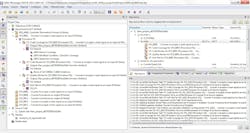LDRA, MathWorks deliver increased integration, move unit testing upstream in workflow
This new integration enables joint customers to benefit from full test reuse and bidirectional traceability throughout the software development life cycle. By bringing all components of the development cycle into one workflow, project teams save time by reusing tests, and more easily track progress toward requirements fulfillment and certification readiness.
Rigorous testing is bottom-line for avionics and automotive certifications, such as DO-178B/C or ISO 26262, where on-target testing is required. With LDRA’s integration of the LDRA tool suite and MathWorks Simulink, Simulink model test vectors can confirm the application is running as expected on the target, and LDRA-generated tests can be fed back into Simulink and used to refine the simulation. Code can then be regenerated to create the highest caliber code, minimizing risk.
Tests are reused for target and model, reducing time otherwise used to generate and prove test regimens for both phases. When this testing capability is coupled with standard-specific templates, companies gain a streamlined process that details both the process and requirements needed for compliance.
TBmanager, a requirements traceability and test product within the LDRA tool suite, links and graphically depicts relationships between requirements and relevant models, code and test artifacts. This information matrix highlights the linkages between software components that auditors can review to see how companies have identified and corrected program errors and addressed non-compliance until the entire application fulfils requirement specifications. Such transparency into application relationships organizes and speeds team progress by automating development and documentation.
Together, Simulink and the LDRA tool suite create instrumented code that can be built using the selected compiler and executed via the LDRA tool suite. The combination enables full code coverage, whether statement, branch or decision, or modified condition/decision coverage (MC/DC) of code created from Simulink models and manual code. In addition, data values used to exercise the model in simulated environments can be leveraged to test generated code for SIL (software-in-the-loop) and PIL (processor-in-the-loop) on the target as well as generating additional tests through LDRA’s unit test facility. The textural and graphical output indicates coverage both as absolute values and in relation to a set of limits required by a standards body like DO-178.
